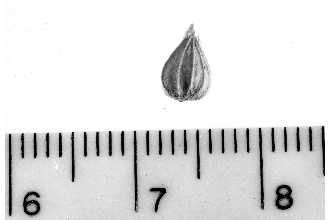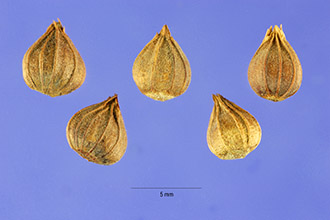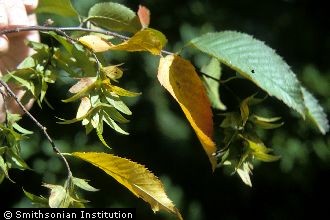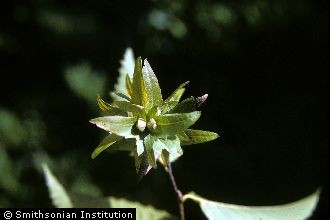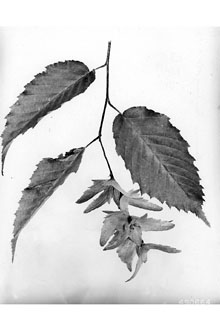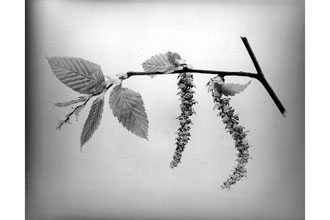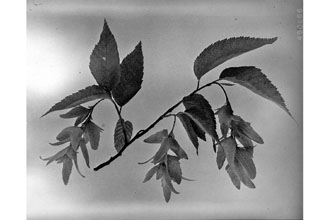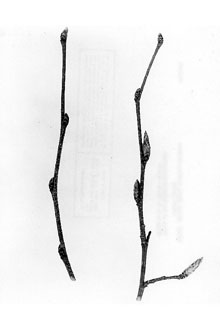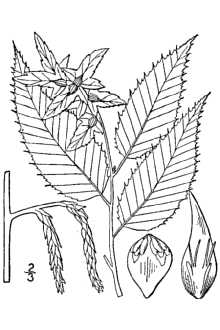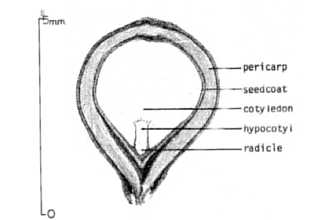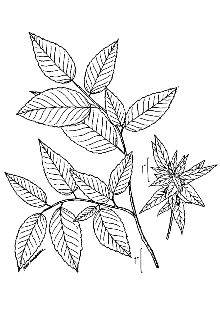American Hornbeam
Scientific Name: Carpinus caroliniana Walter
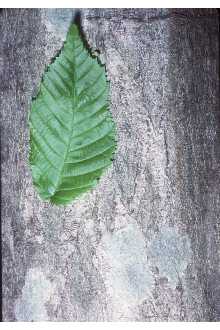
| General Information | |
|---|---|
| Usda Symbol | CACA18 |
| Group | Dicot |
| Life Cycle | Perennial |
| Growth Habits | ShrubTree, |
| Native Locations | CACA18 |
Plant Guide
Alternate Names
Ironwood, musclewood, muscle beech, blue beech, water beech
Uses
The wood of Carpinus is of minor economic importance because of the small size of the trees. It is whitish, extremely hard, and heavy and has been used for making mallet heads, tool handles, levers, and other small, hard, wooden objects. The wood is not subject to cracking or splitting and was used by American pioneers for bowls and dishes. American hornbeam is planted in landscapes and naturalized areas. It prefers deep, fertile, moist, acidic soil and grows best in partial shade, but will grow in full sun. Its chief liabilities in cultivation are a relatively slow growth rate and difficulty in transplantation. It is not drought-tolerant. Seeds, buds, or catkins are eaten by a number of songbirds, ruffed grouse, ring-necked pheasants, bobwhite, turkey, fox, and gray squirrels. Cottontails, beaver, and white-tailed deer eat the leaves, twigs, and larger stems. Beaver heavily uses American hornbeam, because it is readily available in typical beaver habitat. © William S. Justice Dept. of Botany, Smithsonian Institution @ PLANTS
Status
Please consult the PLANTS Web site and your State Department of Natural Resources for this plant’s current status, such as, state noxious status and wetland indicator values.
Description
General: Birch Family (Betulaceae). American hornbeam is a native, large shrub or small tree with a wide-spreading, flat-topped crown, the stems slender, dark brown, hairy; bark gray, thin, usually smooth, with smooth, longitudinal fluting (resembling a flexed muscle). Its leaves are deciduous, simple, alternate, ovate to elliptic, 3-12 cm long, with doubly-serrate edges, dark green, turning yellow to orange or red in the fall, glabrous above, slightly to moderately pubescent beneath, especially on major veins, with or without conspicuous dark glands. The flowers are unisexual, in catkins, the male (staminate) catkins 2-6 cm long, female (pistillate) catkins 1-2.5 cm long, both types on the same plant (the species monoecious). Fruits are a nutlet 4-6 mm long, subtended by a 3-winged, narrow, leaf-like bract, numerous nutlets held together in pendulous chain-like clusters 2.5-12 cm long, changing from green to brown in September-October. The common name, beam, is an Old English word for tree, with horn suggesting an analogy of the hard, close-grained wood to the tough material of horns. Variation within the species: the two subspecies are distinguished by morphology and geography. They hybridize or intergrade where their ranges overlap in a broad band running from the Carolinas south to northern Georgia and westward to Missouri, Arkansas, and southeastern Oklahoma. Plants with intermediate features are also found throughout the highlands of Missouri and Arkansas. 1. Leaf blades narrowly ovate to oblong-ovate, 3-8.5(-12) cm long, acute to obtuse at the tip; secondary teeth blunt and small; lower surfaces without small dark glands; southern Atlantic and Gulf of Mexico coastal plains and also extends northward in the Mississippi Embayment. ............. subsp. caroliniana 2. Leaf blades ovate to elliptic, mostly 8-12 cm long, usually abruptly narrowing at the tip, sometimes long and gradually tapered; secondary teeth sharp-tipped, often almost as large as primary teeth; lower surfaces covered with tiny, dark glands; Appalachians and interior forested northeastern North America. ...................... subsp. virginiana (Marsh.) Furlow Trees of temperate forests in the mountains of Mexico and Central America, formerly considered to be part of Carpinus caroliniana, are now treated as C. tropicalis (J.D. Smith) Lundell spp. tropicalis and C. tropicalis ssp. mexicana Furlow. Distribution: Widespread in the eastern United States --- from central Maine west to southwestern Quebec, southeastern Ontario, northern Michigan, and northern Minnesota, south to central Iowa and eastern Texas, east to central Florida. Absent from the lowermost Gulf Coastal Plain and the Mississippi embayment south of Missouri).
Adaptation
American hornbeam occurs primarily as an understory species in bottomland mixed-hardwood forests. Best sites are in the transition between mesic and wet areas -- near lakes and swamps, on well-drained terraces of rivers, terraces or steep slopes of minor streams with some gradient, coves, ravine bottoms, and rises in lowlands. These sites generally have abundant soil moisture but sufficient drainage to prevent saturation and poor aeration during the growing season, although trees may be abundant on sites flooded for up to about 20% of the growing season. American hornbeam occurs less commonly in upland hardwood forests and may range from 300-900 meters elevation in the Appalachian and Adirondack Mountains. In the northeastern US, it may be an early migrant and form pure stands in moist old fields; it may be a minor seral component of sapling-size tree-shrub communities along the mid-Atlantic coast. Flowering: March-May; fruiting: August-October.
Establishment
American hornbeam begins to produce seeds at about 15 years and peaks at 25 to 50 years, probably ceasing at about 75 years. Large seed crops are produced at 3-5-year intervals. Seeds are mainly dispersed by birds. Seed establishment will occur on leaf litter in deep shade. Flooding, drought, damping off, proximity to a conspecific adult, and herbivory are important causes of mortality for first-year seedlings. Reproduction also may occur by sprouts from the root crown and by root sprouts, although the latter apparently is not common. American hornbeam is best suited to establishment in bottomlands that have already been stabilized by pioneer species. It is shade-tolerant and persists in the understory of late seral and climax communities. Shade tolerance declines with age and American hornbeam is likely to become dominant, with other subcanopy species, at some sites after overstory removal.
Management
Because of its thin bark, American hornbeam is probably either top-killed or completely killed by most fires. It occurs mostly in communities that rarely experience fire. It sprouts after top-kill by fire and repeated fires at a closely spaced interval will quickly eliminate the species. The wood rots very rapidly and dying trees usually disappear naturally within a decade. Cultivars, Improved and Selected Materials (and area of origin) Contact your local Natural Resources
Conservation
Service (formerly Soil Conservation Service) office for more information. Look in the phone book under ”United States Government.” The Natural Resources Conservation Service will be listed under the subheading “Department of Agriculture.”
References
Delcourt, H,R, & P,A, Delcourt 1994, Postglacial rise and decline of Ostrya virginiana (Mill,) K, Koch and Carpinus caroliniana Walt, in eastern North America: predictable responses of forest species to cyclic changes in seasonality of climates, J, Biogeogr, 21:137-150, Furlow, J,J, 1987, The Carpinus caroliniana complex in North America, I, A multivariate analysis of geographical variation, Syst, Bot, 12:21-40, Furlow, J,J, 1987, The Carpinus caroliniana complex in North America, II, Systematics, Syst, Bot, 12:416-434, Furlow, J,J, 1990, The genera of Betulaceae in the southeastern United States, J, Arnold Arbor, 71:1-67, Furlow, J,J, 1993, Carpinus, Pp, 531-533, IN: Flora of North America, north of Mexico, Vol, 3, Oxford Univ, Press, New York, <http://hua,huh,harvard,edu/cgi-bin/Flora/flora,pl?FLORA_ID=12395> Metzger, F,T, 1990, Carpinus carolinianus Walt, American hornbeam, Use soil moisture sensors to measure the soil moisture of American Hornbeam., Pp, 179-185, IN: R,M, Burns and B,H, Honkala, Silvics of North America, Volume 2, Hardwoods, USDA, Forest Service Agric, Handbook 654, Washington, D,C, <http://willow,ncfes,umn,edu/silvics_manual/Table_of_contents,htm> Sullivan, J, 1994, Carpinus caroliniana, In: W,C, Fischer (compiler), The Fire Effects Information System [Data base], USDA, Forest Service, Intermountain Research Station, Intermountain Fire Science Laboratory, Missoula, Montana, <http://www,fs,fed,us/database/feis/> Wardell, G,I, & J,E, Winstead 1978, Population differences in bud bursting of Carpinus caroliniana Walter, Trans, Kentucky Acad, Sci, 39:127-130, Winstead, J,E,, B,J, Smith, & G,I, Wardell 1977, Fruit weight clines in populations of ash, ironwood, cherry, dogwood and maple, Castanea 42:56-60,
Fact Sheet
Alternate Names
ironwood, musclewood, muscle beech, blue beech, water beech
Uses
The wood of Carpinus is of minor economic importance because of the small size of the trees. It is whitish, extremely hard, and heavy and has been used for making mallet heads, tool handles, levers, and other small, hard, wooden objects. The wood is not subject to cracking or splitting and was used by American pioneers for bowls and dishes. American hornbeam is planted in landscapes and naturalized areas. It prefers deep, fertile, moist, acidic soil and grows best in partial shade, but will grow in full sun. Its chief liabilities in cultivation are a relatively slow growth rate and difficulty in transplantation. It is not drought-tolerant. Seeds, buds, or catkins are eaten by a number of songbirds, ruffed grouse, ring-necked pheasants, bobwhite, turkey, fox, and gray squirrels. Cottontails, beaver, and white-tailed deer eat the leaves, twigs, and larger stems. American hornbeam is heavily used by beaver, because it is readily available in typical beaver habitat. © William S. Justice Dept. of Botany, Smithsonian Institution @ PLANTS
Status
Please consult the PLANTS Web site and your State Department of Natural Resources for this plant’s current status (e.g. threatened or endangered species, state noxious status, and wetland indicator values).
Description
American hornbeam is a native, large shrub or small tree with a wide-spreading, flat-topped crown, the stems are slender, dark brown, hairy; bark gray, thin, usually smooth, with smooth, longitudinal fluting (resembling a flexed muscle). Its leaves are deciduous, arranged alternately along stems, egg-shaped to elliptical in outline, ¾ to 4¾ inches long, with doubly-serrate edges. They are glabrous above, slightly to moderately pubescent beneath, especially on major veins, with or without conspicuous dark glands. During the growing season, leaves are dark green but turn yellow to orange or red in the fall. The flowers are unisexual, in catkins. The male catkins are 1 to 2½ inches long, female catkins are somewhat shorter. Both types occur on the same plant). Fruits are nutlets surrounded by a 3-winged, narrow, leaf-like bract. Numerous nutlets are held together in pendulous chain-like clusters, changing from green to brown in September-October.
Adaptation and Distribution
Distribution
Distribution
American hornbeam occurs primarily as an understory species in bottomland mixed-hardwood forests, Best sites are in the transition between mesic and wet areas -- near lakes and swamps, on well-drained terraces of rivers, terraces or steep slopes of minor streams with some gradient, coves, ravine bottoms, and rises in lowlands, These sites generally have abundant soil moisture but sufficient drainage to prevent saturation and poor aeration during the growing season, although trees may also grow on sites flooded for up to about 20% of the growing season, American hornbeam is distributed throughout most of the eastern United States, For a current distribution map, please consult the Plant Profile page for this species on the PLANTS Web site, Use soil moisture sensors to measure the soil moisture of American Hornbeam.,
Establishment
American hornbeam is planted in landscapes and naturalized areas. It prefers deep, fertile, moist, acidic soil and grows best in partial shade, but will grow in full sun. Its chief liabilities in cultivation are a relatively slow growth rate and difficulty in transplantation. It is not drought-tolerant. American hornbeam begins to produce seeds at about 15 years and peaks at 25 to 50 years, probably ceasing at about 75 years. Large seed crops are produced at 3-5-year intervals. Seeds are mainly dispersed by birds. Seed establishment will occur on leaf litter in deep shade. Flooding, drought, damping off, proximity to an adult of the same species, and herbivory are important causes of mortality for first-year seedlings. Reproduction also may occur by sprouts from the root crown and by root sprouts, although the latter apparently is not common. American hornbeam is best suited to establishment in bottomlands that have already been stabilized by pioneer species. It is shade-tolerant and persists in the understory of mature plant communities. Shade tolerance declines with age and American hornbeam is likely to become dominant, with other subcanopy species, at some sites after overstory removal.
Plant Traits
Growth Requirements
| Temperature, Minimum (°F) | -34 |
|---|---|
| Adapted to Coarse Textured Soils | Yes |
| Adapted to Fine Textured Soils | No |
| Adapted to Medium Textured Soils | Yes |
| Anaerobic Tolerance | Low |
| CaCO3 Tolerance | Low |
| Cold Stratification Required | Yes |
| Drought Tolerance | Low |
| Fertility Requirement | Medium |
| Fire Tolerance | Low |
| Frost Free Days, Minimum | 80 |
| Hedge Tolerance | Low |
| Moisture Use | Medium |
| pH, Maximum | 7.4 |
| pH, Minimum | 4.0 |
| Planting Density per Acre, Maxim | 1200 |
| Planting Density per Acre, Minim | 700 |
| Precipitation, Maximum | 80 |
| Precipitation, Minimum | 23 |
| Root Depth, Minimum (inches) | 20 |
| Salinity Tolerance | None |
| Shade Tolerance | Tolerant |
Morphology/Physiology
| Bloat | None |
|---|---|
| Toxicity | None |
| Resprout Ability | Yes |
| Shape and Orientation | Erect |
| Active Growth Period | Spring and Summer |
| C:N Ratio | High |
| Coppice Potential | No |
| Fall Conspicuous | Yes |
| Fire Resistant | No |
| Flower Color | Orange |
| Flower Conspicuous | Yes |
| Foliage Color | Green |
| Foliage Porosity Summer | Dense |
| Foliage Porosity Winter | Porous |
| Foliage Texture | Medium |
| Fruit/Seed Conspicuous | No |
| Nitrogen Fixation | None |
| Low Growing Grass | No |
| Lifespan | Short |
| Leaf Retention | No |
| Known Allelopath | No |
| Height, Mature (feet) | 30.0 |
| Height at 20 Years, Maximum (fee | 18 |
| Growth Rate | Slow |
| Growth Form | Multiple Stem |
| Fruit/Seed Color | Brown |
Reproduction
| Vegetative Spread Rate | None |
|---|---|
| Small Grain | No |
| Seedling Vigor | Low |
| Seed Spread Rate | Slow |
| Seed per Pound | 35000 |
| Fruit/Seed Persistence | No |
| Propagated by Tubers | No |
| Propagated by Sprigs | No |
| Propagated by Sod | No |
| Propagated by Seed | Yes |
| Propagated by Corm | No |
| Propagated by Cuttings | No |
| Bloom Period | Mid Spring |
| Commercial Availability | Routinely Available |
| Fruit/Seed Abundance | Medium |
| Fruit/Seed Period Begin | Summer |
| Fruit/Seed Period End | Fall |
| Propagated by Bare Root | Yes |
| Propagated by Bulb | No |
| Propagated by Container | Yes |
Suitability/Use
| Veneer Product | No |
|---|---|
| Pulpwood Product | No |
| Protein Potential | Low |
| Post Product | No |
| Palatable Human | No |
| Palatable Graze Animal | Low |
| Palatable Browse Animal | Low |
| Nursery Stock Product | Yes |
| Naval Store Product | Yes |
| Lumber Product | No |
| Fuelwood Product | High |
| Fodder Product | No |
| Christmas Tree Product | No |
| Berry/Nut/Seed Product | No |

